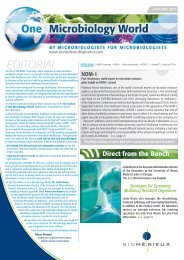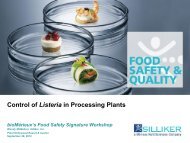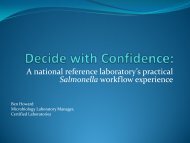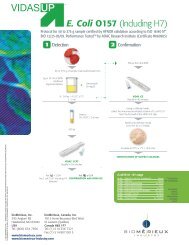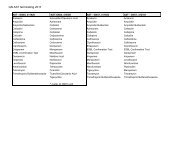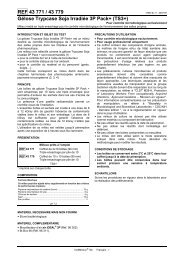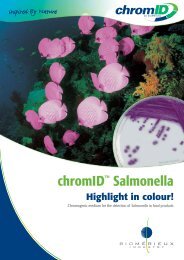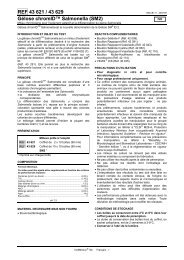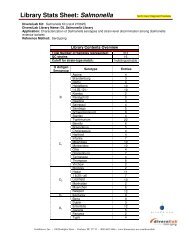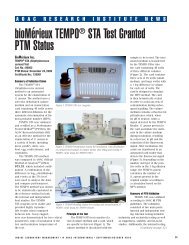Antibiotic Classification and Modes of Action - bioMerieux
Antibiotic Classification and Modes of Action - bioMerieux
Antibiotic Classification and Modes of Action - bioMerieux
Create successful ePaper yourself
Turn your PDF publications into a flip-book with our unique Google optimized e-Paper software.
Customer Education <strong>Antibiotic</strong> <strong>Classification</strong><br />
Part # 60-00415-0<br />
<strong>Antibiotic</strong> <strong>Classification</strong><br />
<strong>and</strong><br />
<strong>Modes</strong> <strong>of</strong> <strong>Action</strong><br />
© bioMérieux, Inc., Customer Education<br />
March 2008<br />
1
Customer Education <strong>Antibiotic</strong> <strong>Classification</strong><br />
bioMérieux, the blue logo <strong>and</strong> VITEK are used, pending <strong>and</strong>/or registered trademarks<br />
belonging to bioMérieux SA or one <strong>of</strong> its subsidiaries.<br />
CLSI is a registered trademark <strong>of</strong> Clinical Laboratory <strong>and</strong> St<strong>and</strong>ards Institute, Inc.<br />
Zyvox is a registered trademark <strong>of</strong> Pfizer Caribe Limited.<br />
Tequin is a registered trademark <strong>of</strong> Bristol-Myers Squibb Company.<br />
© bioMérieux, Inc., Customer Education<br />
March 2008<br />
2
Customer Education <strong>Antibiotic</strong> <strong>Classification</strong><br />
<strong>Antibiotic</strong> <strong>Classification</strong><br />
Module<br />
Objectives<br />
Upon completion <strong>of</strong> this module you will be able to:<br />
• Explain why susceptibility testing is done<br />
• Define the terms, bacteriostatic <strong>and</strong> bactericidal<br />
• Describe the functional antibiotic classification scheme <strong>and</strong> list<br />
the 5 main groups<br />
• Name at least one antibiotic in each class<br />
• Describe the structure <strong>of</strong> a Gram-positive <strong>and</strong> negative cell<br />
• Explain the modes <strong>of</strong> action for the antibiotics in each <strong>of</strong> the five<br />
functional antibiotic classes<br />
• List examples <strong>of</strong> natural resistance in each <strong>of</strong> the five functional<br />
antibiotic classes<br />
• Explain why it is not necessary to perform susceptibility testing<br />
for certain organism / antibiotic combinations<br />
© bioMérieux, Inc., Customer Education<br />
March 2008<br />
3
Customer Education <strong>Antibiotic</strong> <strong>Classification</strong><br />
<strong>Antibiotic</strong>s<br />
&<br />
Susceptibility Testing<br />
Microbiologists work with antibiotics every day.<br />
Antimicrobial Susceptibility Testing (AST) is one <strong>of</strong> the primary functions <strong>of</strong><br />
the Microbiology Lab.<br />
But, how much do Microbiologists really know about antibiotics?<br />
Let’s review some basic information <strong>and</strong> see how it can be applied daily.<br />
© bioMérieux, Inc., Customer Education<br />
March 2008<br />
4
Customer Education <strong>Antibiotic</strong> <strong>Classification</strong><br />
What is an <strong>Antibiotic</strong>?<br />
<strong>Antibiotic</strong> is a chemical substance produced by<br />
a microorganism that inhibits the growth <strong>of</strong> or<br />
kills other microorganisms.<br />
Antimicrobial agent is a chemical substance<br />
derived from a biological source or produced<br />
by chemical synthesis that kills or inhibits the<br />
growth <strong>of</strong> microorganisms.<br />
The noun “antibiotic” was first used in 1942 by Dr. Selman A.<br />
Waksman, soil microbiologist. Dr. Waksman <strong>and</strong> his colleagues<br />
discovered several actinomycetes derived antibiotics.<br />
The two terms are usually used synonymously <strong>and</strong> that practice will<br />
continue throughout this presentation.<br />
The word “antibiotic” will be used to describe:<br />
a chemical substance derivable from a microorganism or<br />
produced by chemical synthesis that kills or inhibits<br />
microorganisms <strong>and</strong> cures infections.<br />
© bioMérieux, Inc., Customer Education<br />
March 2008<br />
5
Customer Education <strong>Antibiotic</strong> <strong>Classification</strong><br />
Sources <strong>of</strong> Antibacterial Agents<br />
• Natural - mainly fungal sources<br />
• Semi-synthetic - chemically-altered natural compound<br />
• Synthetic - chemically designed in the lab<br />
Toxicity<br />
Natural<br />
Semi-synthetic<br />
Effectiveness<br />
Synthetic<br />
• The original antibiotics were derived from fungal sources. These can<br />
be referred to as “natural” antibiotics<br />
• Organisms develop resistance faster to the natural antimicrobials<br />
because they have been pre-exposed to these compounds in<br />
nature. Natural antibiotics are <strong>of</strong>ten more toxic than synthetic<br />
antibiotics.<br />
• Benzylpenicillin <strong>and</strong> Gentamicin are natural antibiotics<br />
• Semi-synthetic drugs were developed to decrease toxicity <strong>and</strong> increase<br />
effectiveness<br />
• Ampicillin <strong>and</strong> Amikacin are semi-synthetic antibiotics<br />
• Synthetic drugs have an advantage that the bacteria are not exposed to<br />
the compounds until they are released. They are also designed to have<br />
even greater effectiveness <strong>and</strong> less toxicity.<br />
• Moxifloxacin <strong>and</strong> Norfloxacin are synthetic antibiotics<br />
• There is an inverse relationship between toxicity <strong>and</strong> effectiveness as<br />
you move from natural to synthetic antibiotics<br />
© bioMérieux, Inc., Customer Education<br />
March 2008<br />
6
Customer Education <strong>Antibiotic</strong> <strong>Classification</strong><br />
Role <strong>of</strong> <strong>Antibiotic</strong>s<br />
What is the role <strong>of</strong> antibiotics?<br />
• To inhibit multiplication<br />
<strong>Antibiotic</strong>s have a bacteriostatic effect.<br />
At which drug concentration is the<br />
bacterial population inhibited?<br />
• Minimal Inhibitory Concentration = MIC<br />
Bacteriostatic = inhibits bacterial growth<br />
© bioMérieux, Inc., Customer Education<br />
March 2008<br />
7
Customer Education <strong>Antibiotic</strong> <strong>Classification</strong><br />
1 ml<br />
10<br />
Mueller<br />
Hinton 1 ml<br />
7 CFU<br />
Quantitative Measure<br />
MIC – Broth Dilution Reference Technique<br />
0 0.5 0.5 1 1 2 2 4 4 8 8 16 16 µg/ml<br />
µg/ml<br />
35°C - 16 - 20 h<br />
0 0.5 1 2 MIC = 4 8 16<br />
µg/ml<br />
• MIC = lowest concentration <strong>of</strong> antibiotic that inhibits growth<br />
(measured visually)<br />
• Interpretation <strong>of</strong> quantitative susceptibility tests is based on:<br />
� relationship <strong>of</strong> the MIC to the achievable concentration <strong>of</strong><br />
antibiotic in body fluids with the dosage given<br />
� For treatment purposes, the dosage <strong>of</strong> antibiotic given should<br />
yield a peak body fluid concentration 3-5 times higher than the<br />
MIC<br />
or<br />
� MIC x 4 = dosage to obtain peak achievable concentration<br />
© bioMérieux, Inc., Customer Education<br />
March 2008<br />
8
Customer Education <strong>Antibiotic</strong> <strong>Classification</strong><br />
Role <strong>of</strong> <strong>Antibiotic</strong>s<br />
What is the role <strong>of</strong> antibiotics?<br />
• To destroy the bacterial population<br />
<strong>Antibiotic</strong>s have a bactericidal effect.<br />
At which drug concentration is the<br />
bacterial population killed?<br />
• Minimal Bactericidal Concentration = MBC<br />
Bactericidal = kills bacteria<br />
© bioMérieux, Inc., Customer Education<br />
March 2008<br />
9
Customer Education <strong>Antibiotic</strong> <strong>Classification</strong><br />
MBC – Reference Technique<br />
0 0.5 1 2 MIC = 4 8 16<br />
µg/ml<br />
10 µl<br />
Quantitative Measure<br />
0 µg/ml<br />
4 µg/ml<br />
8 µg/ml<br />
16 µg/ml MBC = 16<br />
µg/ml<br />
• MBC = lowest concentration <strong>of</strong> antibiotic that kills bacteria<br />
© bioMérieux, Inc., Customer Education<br />
March 2008<br />
10
Customer Education <strong>Antibiotic</strong> <strong>Classification</strong><br />
MIC MBC<br />
Relationship <strong>of</strong> MIC/MBC<br />
1 2 4 8 16 32 64 128<br />
Bactericidal<br />
MIC MBC<br />
1<br />
1 2 4 8 16 32 64 128<br />
Bacteriostatic<br />
There is a much closer relationship between the MIC <strong>and</strong> MBC values<br />
for bactericidal drugs than for bacteriostatic drugs.<br />
© bioMérieux, Inc., Customer Education<br />
March 2008<br />
11
Customer Education <strong>Antibiotic</strong> <strong>Classification</strong><br />
How Do <strong>Antibiotic</strong>s Work?<br />
�Mechanisms <strong>of</strong> <strong>Action</strong><br />
-<strong>Antibiotic</strong>s operate by inhibiting crucial life<br />
sustaining processes in the organism:<br />
the synthesis <strong>of</strong> cell wall material<br />
the synthesis <strong>of</strong> DNA, RNA, ribosomes<br />
<strong>and</strong> proteins.<br />
�Target<br />
–The target <strong>of</strong> the antibiotic should be<br />
selective to minimize toxicity…but all<br />
antibiotics are toxic to some degree!<br />
The targets <strong>of</strong> antibiotics should be selective to minimize toxicity.<br />
• Selective Toxicity<br />
� Harm the bacteria, not the host<br />
© bioMérieux, Inc., Customer Education<br />
March 2008<br />
12
Customer Education <strong>Antibiotic</strong> <strong>Classification</strong><br />
Why Do Susceptibility Testing?<br />
• Help patients today<br />
- To provide guidance to the physician in<br />
selection <strong>of</strong> antimicrobial therapy with the<br />
expectation <strong>of</strong> optimizing outcome<br />
• Help patients tomorrow<br />
- Build an antibiogram to guide physicians in<br />
selecting empiric therapy for future patients<br />
with the expectation <strong>of</strong> optimizing outcome<br />
• Help patients next decade<br />
- Drive new drug research<br />
- Monitor the evolution <strong>of</strong> resistance<br />
We do this testing:<br />
• To provide a guide for therapy<br />
• Allows selection <strong>of</strong> the most appropriate agent<br />
Least expensive<br />
Narrowest spectrum<br />
Most effective<br />
• To monitor the evolution <strong>of</strong> resistance<br />
<strong>Antibiotic</strong> resistance has an impact on individual health <strong>and</strong> public health.<br />
• Types <strong>of</strong> resistance seen <strong>and</strong> frequency<br />
• Which drugs you can expect to be successful<br />
• Emerging <strong>and</strong> new resistance seen in the community<br />
© bioMérieux, Inc., Customer Education<br />
March 2008<br />
13
Customer Education <strong>Antibiotic</strong> <strong>Classification</strong><br />
Host Factors<br />
Immune System<br />
Underlying Diseases<br />
Barrier Status<br />
Foreign Bodies<br />
Site <strong>of</strong> Infection<br />
CNS<br />
Intravascular<br />
Pulmonary<br />
Surgical Intervention<br />
Why Do Antimicrobials Fail?<br />
In Vitro<br />
Testing<br />
MIC & S/R<br />
© bioMérieux, Inc., Customer Education<br />
March 2008<br />
<strong>Antibiotic</strong> Properties<br />
PK <strong>and</strong> PD<br />
Metabolism & Elimination<br />
Tissue Penetration<br />
Adverse Event Pr<strong>of</strong>ile<br />
Pathogen<br />
Species<br />
Virulence Factors<br />
Resistance Mechanisms<br />
There are many possible reasons antimicrobials may fail.<br />
Selection <strong>of</strong> the appropriate antibiotic depends on:<br />
� knowledge <strong>of</strong> organism’s natural resistance<br />
� pharmacological properties <strong>of</strong> the antibiotic toxicity, binding,<br />
distribution, absorption achievable levels in blood, urine<br />
� previous experience with same species<br />
� nature <strong>of</strong> patients underlying pathology<br />
� patient’s immune status<br />
Susceptibility testing focuses primarily on the interaction <strong>of</strong> antimicrobial<br />
agents, the organisms <strong>and</strong> their resistance mechanisms.<br />
14
Customer Education <strong>Antibiotic</strong> <strong>Classification</strong><br />
Interpreting Susceptibility Results<br />
• MICs are not physical measurements<br />
• There are many factors that play a role<br />
in determining clinical outcome<br />
• Susceptibility in vitro does not uniformly<br />
predict clinical success in vivo<br />
• Resistance will <strong>of</strong>ten, but not always,<br />
correlate with treatment failure<br />
Susceptibility tests are essentially artificial measurements.<br />
� in vitro response<br />
� approximate range <strong>of</strong> effective inhibitory action<br />
� possible error equivalent to one tube dilution<br />
The only true measure <strong>of</strong> bacterial response to an antibiotic is the clinical<br />
response <strong>of</strong> the patient.<br />
� outcome or in vivo response<br />
One <strong>of</strong> the real values <strong>of</strong> AST is to predict resistance<br />
S = success likely, but no guarantee<br />
R = correlates well with treatment failure<br />
Is Resistance Testing a better name for what we do than Susceptibility<br />
Testing?<br />
© bioMérieux, Inc., Customer Education<br />
March 2008<br />
15
Customer Education <strong>Antibiotic</strong> <strong>Classification</strong><br />
What is the Ideal Antibacterial?<br />
• Selective target – target unique<br />
• Bactericidal – kills<br />
• Narrow spectrum – does not kill normal flora<br />
• High therapeutic index – ratio <strong>of</strong> toxic level to<br />
therapeutic level<br />
• Few adverse reactions – toxicity, allergy<br />
• Various routes <strong>of</strong> administration – IV, IM, oral<br />
• Good absorption<br />
• Good distribution to site <strong>of</strong> infection<br />
• Emergence <strong>of</strong> resistance is slow<br />
© bioMérieux, Inc., Customer Education<br />
March 2008<br />
16
Customer Education <strong>Antibiotic</strong> <strong>Classification</strong><br />
<strong>Antibiotic</strong> <strong>Classification</strong><br />
<strong>and</strong><br />
<strong>Modes</strong> <strong>of</strong> <strong>Action</strong><br />
In the AES Knowledge Base, phenotypes are organized by drug class.<br />
The AES decision process attempts to identify a phenotype for each<br />
drug class tested. In order to underst<strong>and</strong> <strong>and</strong> use the s<strong>of</strong>tware effectively, it<br />
is important to have a solid working knowledge <strong>of</strong> antibiotic classification.<br />
In addition, each drug class typically has a unique mode <strong>of</strong> action.<br />
Bacteria in turn, direct their defenses against these specific modes <strong>of</strong> action.<br />
Underst<strong>and</strong>ing why antibiotics fail begins with the classification <strong>of</strong> antibiotics<br />
<strong>and</strong> their modes <strong>of</strong> action.<br />
© bioMérieux, Inc., Customer Education<br />
March 2008<br />
17
Customer Education <strong>Antibiotic</strong> <strong>Classification</strong><br />
<strong>Antibiotic</strong> <strong>Classification</strong><br />
Grouped by Structure <strong>and</strong> Function<br />
Five functional groups cover most antibiotics<br />
1. Inhibitors <strong>of</strong> cell wall synthesis<br />
2. Inhibitors <strong>of</strong> protein synthesis<br />
3. Inhibitors <strong>of</strong> membrane function<br />
4. Anti-metabolites<br />
5. Inhibitors <strong>of</strong> nucleic acid synthesis<br />
<strong>Antibiotic</strong>s are usually classified based on their structure <strong>and</strong>/or<br />
function.<br />
1. Structure - molecular structure.<br />
� ß-Lactams - Beta-lactam ring<br />
� Aminoglycosides - vary only by side chains attached to basic<br />
structure<br />
2. Function - how the drug works, its mode <strong>of</strong> action.<br />
� 5 functional groups<br />
� These are all components or functions necessary for bacterial<br />
growth<br />
� Targets for antibiotics<br />
In these discussions, we will primarily use the functional classification, but<br />
will point out where structural similarities also exist.<br />
© bioMérieux, Inc., Customer Education<br />
March 2008<br />
18
Customer Education <strong>Antibiotic</strong> <strong>Classification</strong><br />
1. Inhibitors <strong>of</strong> Cell Wall Synthesis<br />
� Beta-lactams<br />
Penicillins<br />
Cephalosporins<br />
Monobactams<br />
Carbapenems<br />
Glycopeptides<br />
Fosfomycins<br />
Inhibitors <strong>of</strong> Cell Wall Synthesis<br />
Beta-lactams<br />
• There are about 50 different Beta (ß)-lactams currently on the market<br />
• They are all bactericidal<br />
• They are non-toxic (i.e., they can be administered at high doses)<br />
• They are relatively inexpensive<br />
• Beta-lactams are organic acids <strong>and</strong> most are soluble in water<br />
© bioMérieux, Inc., Customer Education<br />
March 2008<br />
19
Customer Education <strong>Antibiotic</strong> <strong>Classification</strong><br />
Beta-lactams<br />
R’--CONH<br />
1. Inhibitors <strong>of</strong> Cell Wall Synthesis<br />
O<br />
Inhibitors <strong>of</strong> Cell Wall Synthesis<br />
Beta-lactams<br />
B-lactam<br />
ring<br />
• Similar in structure, as well as, function<br />
• All have a common structural ß-lactam ring<br />
• <strong>Antibiotic</strong>s vary by side chains attached<br />
© bioMérieux, Inc., Customer Education<br />
March 2008<br />
COOH<br />
• All beta-lactams are subject to inactivation by bacterial-produced<br />
enzymes called beta-lactamases<br />
Some more common Beta-lactamase enzymes include:<br />
Penicillinases<br />
Cephalosporinases<br />
ESBL’s<br />
Cephamycinases<br />
Carbapenemases<br />
20
Customer Education <strong>Antibiotic</strong> <strong>Classification</strong><br />
1. Inhibitors <strong>of</strong> Cell Wall Synthesis<br />
Beta-lactams (Penicillins) International Common Name<br />
Penicillins<br />
(pen G)*<br />
Penicillin G<br />
Penicillinase-stable penicillins Oxacillin<br />
(pen M)<br />
Methicillin<br />
Aminopenicillins*<br />
Ampicillin<br />
(pen A)<br />
Amoxicillin<br />
Carboxypenicillins*<br />
(pen C)<br />
Ticarcillin<br />
Ureidopenicillins*<br />
(pen U)<br />
Piperacillin<br />
β-lactam / β-lactamase inhibitor Amoxicillin + clavulanic acid<br />
combinations<br />
Ampicillin + sulbactam<br />
Ticarcillin + clavulanic acid<br />
Piperacillin + tazobactam<br />
Amidinopenicillin Mecillinam<br />
* Penicillinase labile: hydrolyzed by staphylococcal penicillinase<br />
Inhibitors <strong>of</strong> Cell Wall Synthesis<br />
Beta-lactams - Penicillins<br />
Spectrum <strong>of</strong> <strong>Action</strong><br />
1. Natural penicillins<br />
• Penicillin G: Active against Gram-positive organisms that do not<br />
produce beta-lactamases, Neisseria <strong>and</strong> some anaerobes<br />
2. Penicillinase-resistant penicillins<br />
• Penicillin M: Active against penicillinase-producing Staphylococci<br />
3. Extended-spectrum penicillins<br />
• Aminopenicillins: Slightly less active than Penicillin G against<br />
Pneumococci, Streptococci <strong>and</strong> Meningococci, but active against many<br />
strains <strong>of</strong> Salmonella, Shigella, <strong>and</strong> P.mirabilis, H.influenzae)<br />
• Carboxypenicillins: More stable than aminopenicillins to hydrolysis by<br />
the ß-lactamases <strong>of</strong> most Enterobacteriaceae <strong>and</strong> Pseudomonas<br />
aeruginosa<br />
• Ureidopenicillins: Greater activity than carboxypenicillins against<br />
Gram-positives, enterics <strong>and</strong> P.aeruginosa<br />
4. Co-Drugs (Beta-lactam + beta-lactamase inhibitor)<br />
• ß-lactamase inhibitors (BLI) combinations: Additional activity<br />
against beta-lactamase producing organisms, including Staphylococcus<br />
spp., some enterics, H.influenzae <strong>and</strong> Bacterioides spp<br />
5. Amidinopenicillins<br />
• Mecillinam: Restricted use to urinary infection with E.coli. Active<br />
against penicillinase <strong>and</strong> low-level cephalosporinase.<br />
© bioMérieux, Inc., Customer Education<br />
March 2008<br />
21
Customer Education <strong>Antibiotic</strong> <strong>Classification</strong><br />
1. Inhibitors <strong>of</strong> Cell Wall Synthesis<br />
Beta-lactamase Inhibitors (BLI)<br />
Aim: to block β-lactamases<br />
These enzymatic inhibitors have weak or poor<br />
antibacterial activity alone, but a strong affinity for βlactamases:<br />
Clavulanic Acid<br />
Sulbactam<br />
Tazobactam<br />
Combination β-lactams - β-lactamase inhibitor:<br />
Amoxicillin + Clavulanic Acid<br />
Ampicillin + Sulbactam<br />
Ticarcillin + Clavulanic Acid<br />
Piperacillin + Tazobactam<br />
© bioMérieux, Inc., Customer Education<br />
March 2008<br />
Never<br />
Alone!<br />
Beta-lactamase inhibitors (BLI) have a beta(ß)-lactam ring, but have weak or<br />
poor antibacterial activity.<br />
• They have a very high affinity for ß-lactamases<br />
• They act as a trap, <strong>and</strong> are hydrolyzed in preference to the ß-lactam drug.<br />
The drug is left intact to act on the bacteria (cell wall).<br />
• Should be called penicillinase inhibitors, because they are active against:<br />
� Staph penicillinase<br />
� Penicillinase <strong>of</strong> K. pneumoniae<br />
� ESBL (to a greater or lesser degree) - if the penicillinase is being<br />
overproduced, the inhibitor effect may be diluted (Inoculum Effect)<br />
In the case <strong>of</strong> penicillinase production, where:<br />
� Amoxicillin � R<br />
� Amoxicillin + Clavulanic acid � usually S<br />
• Inhibitors are active against all penicillinase (PASE <strong>and</strong> ESBL) but never on<br />
cephalosporinase<br />
NEW ISSUE - BLI can act as inducers <strong>and</strong> actually stimulate enzyme (betalactamase)<br />
production. It is possible to see the following:<br />
Pseudo monas Ticarcillin = S Ticarcillin/Clavulanic = R<br />
Enterobacteriaceae Piperacillin = S Piperacillin/Tazobactam = R<br />
22
Customer Education <strong>Antibiotic</strong> <strong>Classification</strong><br />
1. Inhibitors <strong>of</strong> Cell Wall Synthesis<br />
Beta-lactams (Cephems) International Common Name<br />
1 st Generation Cephalosporins Cephalothin<br />
C1G<br />
Cefazolin<br />
2 nd Generation Cephalosporins Cefuroxime<br />
C2G<br />
Cefam<strong>and</strong>ole<br />
Cephamycin (new C2G) Cefoxitin<br />
Cefotetan – removed<br />
3 rd Generation Cephalosporins Cefotaxime<br />
C3G<br />
Ceftazidime<br />
Ceftriaxone<br />
4 th Generation Cephalosporins<br />
C4G<br />
Cefepime<br />
Oral C3G Cefixime<br />
Cefpodoxime<br />
Next Generation Ceftobiprole<br />
Cephalosporins<br />
Ceftaroline<br />
Inhibitors <strong>of</strong> Cell Wall Synthesis<br />
Beta-lactams - Cephems<br />
Spectrum <strong>of</strong> <strong>Action</strong><br />
• 1st generation cephalosporins (C1G): Narrow spectrum; good<br />
Gram-positive activity <strong>and</strong> relatively modest Gram-negative activity.<br />
Inactivated by Gram-neg beta-lactamases (Derived from<br />
Cephalosporium acremonium).<br />
• 2nd generation cephalosporins (C2G): Better Gram-negative<br />
coverage (more beta-lactamase stability), but less Staphylococcal<br />
activity.<br />
• Cephamycins: Remain susceptible in presence <strong>of</strong> Extended<br />
Spectrum ß-lactamase (ESBL) because they are not a substrate for<br />
the enzyme. Can be used as an indicator for ESBL (Derived from<br />
Streptomyces lactamdurans).<br />
- AstraZeneca discontinued its Cefotetan products in June 2006.<br />
Currently available from other manufacturers.<br />
• 3rd generation cephalosporins (C3G): Wider spectrum <strong>of</strong> action<br />
when compared to C1G <strong>and</strong> C2G. Less active than narrow spectrum<br />
agents against Gram-positive cocci, but much more active against the<br />
Enterobacteriaceae <strong>and</strong> Pseudomonas aeruginosa (better betalactamase<br />
stability).<br />
• 4th generation cephalosporins (C4G): Broadest spectrum <strong>of</strong><br />
action. Active against high level cephalosporinases <strong>of</strong><br />
Enterobacteriaceae <strong>and</strong> Pseudomonas aeruginosa (not usually used<br />
with ESBL producing organisms).<br />
None have activity to MRSA or Enterococcus spp.<br />
© bioMérieux, Inc., Customer Education<br />
March 2008<br />
23
Customer Education <strong>Antibiotic</strong> <strong>Classification</strong><br />
New !<br />
1. Inhibitors <strong>of</strong> Cell Wall Synthesis<br />
Inhibitors <strong>of</strong> Cell Wall Synthesis<br />
New Anti- MRSA Cephalosporins<br />
Ceftobiprole<br />
Ceftaroline<br />
A next generation cephalosporins?<br />
Beta-lactams - Cephems - Ceftobiprole<br />
Spectrum <strong>of</strong> <strong>Action</strong><br />
• Next generation cephalosporin: Broad spectrum; active against<br />
the common Gram-negative bacteria. Some Gram-positive activity<br />
(Drug Resistant S. pneumoniae). Notable for activity against MRSA,<br />
unlike any other beta-lactam antibiotic. Bactericidal.<br />
• Not yet FDA approved<br />
• Has been added to CLSI ® M100-S18, 2008 listing <strong>of</strong> antibiotics<br />
• No CLSI breakpoints<br />
• Once FDA approved, can no longer say if Staph is resistant to<br />
Oxacillin, report all beta-lactams as resistant.<br />
© bioMérieux, Inc., Customer Education<br />
March 2008<br />
24
Customer Education <strong>Antibiotic</strong> <strong>Classification</strong><br />
Beta-lactams International Common Name<br />
Monobactams<br />
Penems<br />
1. Inhibitors <strong>of</strong> Cell Wall Synthesis<br />
Carbapenems<br />
Penems<br />
Inhibitors <strong>of</strong> Cell Wall Synthesis<br />
Beta-lactams: Monobactams<br />
Aztreonam<br />
Imipenem<br />
Meropenem<br />
Ertapenem<br />
Doripenem<br />
Faropenem<br />
Spectrum <strong>of</strong> <strong>Action</strong><br />
• Aztreonam: Gram-negatives (Enterobacteriaceae <strong>and</strong><br />
Pseudomonas). Not hydrolyzed by most commonly occurring<br />
plasmid <strong>and</strong> chromosomally mediated ß-lactamases, <strong>and</strong> does not<br />
induce the production <strong>of</strong> these enzymes.<br />
Beta-lactams: Penems<br />
Slightly different structure than the other ß-lactams, make the Penems<br />
much more resistant to beta-lactamase hydrolysis.<br />
Spectrum <strong>of</strong> <strong>Action</strong><br />
• Carbapenems: ß-lactams with a broad spectrum <strong>of</strong> action. Grampositives,<br />
except MRSA. Gram-negatives, Ps. aeruginosa (except<br />
Ertapenem) <strong>and</strong> anaerobes. Very efficient against high level<br />
cephalosporinase <strong>and</strong> ESBL. Wide diffusion in the body, especially<br />
in the cerebrospinal fluid.<br />
Doripenem (new) - Broad spectrum. Particularly good for<br />
Pseudomonas <strong>and</strong> other non-fermenters.<br />
• Penem: Oral. Primarily for respiratory tract infections. Poor activity<br />
with Serratia, Pseudomonas, Stenotrophomonas.<br />
Faropenem not yet FDA approved.<br />
© bioMérieux, Inc., Customer Education<br />
March 2008<br />
25
Customer Education <strong>Antibiotic</strong> <strong>Classification</strong><br />
<strong>Antibiotic</strong> <strong>Modes</strong> <strong>of</strong> <strong>Action</strong><br />
From…<br />
the Bug<br />
© bioMérieux, Inc., Customer Education<br />
March 2008<br />
To…<br />
the Drug<br />
• Before we can underst<strong>and</strong> the antibiotic modes <strong>of</strong> action, we need to<br />
review the structure <strong>and</strong> physiology <strong>of</strong> the bacterial cell<br />
26
Customer Education <strong>Antibiotic</strong> <strong>Classification</strong><br />
Multiplication <strong>of</strong> Bacteria<br />
• It is important to underst<strong>and</strong> the growth cycle <strong>and</strong> physiology <strong>of</strong> bacteria to<br />
appreciate how it influences antimicrobial action<br />
• Bacteria are all around us. Given good growing conditions, a bacterium<br />
will divide.<br />
• A new cell wall forms at the center <strong>and</strong> the "bug" splits into two daughter<br />
cells, both <strong>of</strong> which carry the same genetic information as the parent<br />
• If the environment is perfect, the two daughter cells can split into four<br />
within 20 minutes<br />
• 1, 2, 4, 8, 16, 32, 64...<br />
• Typical bacterial growth cycle includes:<br />
Lag phase<br />
Exponential (log) phase<br />
Stationary phase<br />
Death phase<br />
© bioMérieux, Inc., Customer Education<br />
March 2008<br />
27
Customer Education <strong>Antibiotic</strong> <strong>Classification</strong><br />
1 µ<br />
2.5 µ<br />
Bacterial Structure<br />
1 µ<br />
© bioMérieux, Inc., Customer Education<br />
March 2008<br />
Bacterial wall<br />
(peptidoglycan)<br />
Cytoplasm<br />
Cytoplasmic membrane<br />
Ribosomes<br />
Typical Structure <strong>of</strong> a Bacterial Cell (from inside to outside)<br />
DNA bacterial genetic material<br />
Ribosomes (protein-making factories), energy-generating systems, digestive<br />
system, <strong>and</strong> everything else are located in the cytoplasm.<br />
Cytoplasmic Membrane or Inner Membrane<br />
a. Consists <strong>of</strong> phospholipids <strong>and</strong> other membrane proteins<br />
b. Semi-permeable<br />
c. Regulates pH, osmotic pressure <strong>and</strong> availability <strong>of</strong> essential nutrients<br />
Bacterial Cell Wall or Peptidoglycan<br />
a. Cross-linked mesh that gives a cell its shape, strength <strong>and</strong> osmotic<br />
stability, a protective suit <strong>of</strong> armour<br />
b. Porous up to 100,000 Da<br />
The outer layer <strong>of</strong> lipopolysaccharide (LPS) <strong>and</strong> phospholipid material helps<br />
protect bacteria from bacteriophages, pH, enzymes, phagocytosis.<br />
• To multiply, the bacteria must be able to synthesize peptidoglycan,<br />
proteins <strong>and</strong> DNA<br />
• The cell wall, the ribosomes <strong>and</strong> DNA are all potential antibiotic targets<br />
DNA<br />
28
Customer Education <strong>Antibiotic</strong> <strong>Classification</strong><br />
Peptido -<br />
glycan<br />
Inner<br />
membrane<br />
Gram-Positive Cell Structure<br />
Gram-Positive Gram Positive Cell Structure<br />
PBP Protein<br />
© bioMérieux, Inc., Customer Education<br />
March 2008<br />
Teichoic<br />
acids<br />
• The Gram-positive cell wall is thick <strong>and</strong> consists <strong>of</strong> 90% peptidoglycan<br />
• Teichoic acids link various layers <strong>of</strong> peptidoglycan together. Teichoic<br />
acids also regulate the autolysin activity in this complex equilibrium.<br />
• The cytoplasmic membrane (which defines the intracellular space)<br />
consist <strong>of</strong>:<br />
•a lipid bilayer<br />
• intrinsic proteins which are hydrophobic (mostly enzymes involved<br />
in respiration <strong>and</strong> transmembrane transport)<br />
• extrinsic proteins which are hydrophilic<br />
• Penicillin-Binding Proteins (PBPs): periplasmic space proteins<br />
involved in peptidoglycan synthesis (glycosyltransferase,<br />
transpeptidase <strong>and</strong> carboxypeptidase activities)<br />
29
Customer Education <strong>Antibiotic</strong> <strong>Classification</strong><br />
Gram-Positive Gram Positive Cell Structure<br />
© bioMérieux, Inc., Customer Education<br />
March 2008<br />
30
Customer Education <strong>Antibiotic</strong> <strong>Classification</strong><br />
Outer<br />
membrane<br />
Peptidoglycan<br />
Cytoplasmic<br />
membrane<br />
Gram-Negative Cell Structure<br />
• The outer membrane is made up <strong>of</strong>:<br />
• phospholipids<br />
Gram-Negative Gram Negative Cell Structure<br />
Porin Protein<br />
β−lactamase<br />
PBP Protein<br />
© bioMérieux, Inc., Customer Education<br />
March 2008<br />
Endotoxin = LPS<br />
• endotoxin or lipopolysaccharide (LPS) - plays an important role in<br />
the antibiotic entry into the cell<br />
• proteins including the porins (complexes <strong>of</strong> three proteins)<br />
form aqueous channels that provide a route across the outer<br />
membrane for all the water-soluble compounds needed by the<br />
bacterium<br />
• The periplasmic space contains:<br />
• peptidoglycan – 5-20% <strong>of</strong> cell wall<br />
• various enzymes (in particular, ß-lactamases)<br />
• The cytoplasmic membrane (which defines the intracellular space)<br />
consists <strong>of</strong>:<br />
• a lipid bilayer<br />
• intrinsic proteins which are hydrophobic (mostly enzymes involved<br />
in respiration <strong>and</strong> transmembrane transport)<br />
• extrinsic proteins which are hydrophilic<br />
• Penicillin-Binding Proteins (PBPs) - periplasmic space proteins<br />
involved in peptidoglycan synthesis (glycosyltransferase,<br />
transpeptidase <strong>and</strong> carboxypeptidase activities)<br />
31
Customer Education <strong>Antibiotic</strong> <strong>Classification</strong><br />
Gram-Negative Gram Negative Cell Wall Structure<br />
© bioMérieux, Inc., Customer Education<br />
March 2008<br />
32
Customer Education <strong>Antibiotic</strong> <strong>Classification</strong><br />
Peptidoglycan<br />
N-acetyl<br />
muramic acid<br />
L-ala<br />
D-gluNH2<br />
L-lys<br />
D-ala<br />
D-ala<br />
Peptidoglycan Structure<br />
gly<br />
N-acetyl<br />
glucosamine<br />
gly<br />
gly<br />
gly<br />
gly<br />
N-acetyl<br />
glucosamine<br />
© bioMérieux, Inc., Customer Education<br />
March 2008<br />
D-ala<br />
D-ala<br />
L-lys<br />
D-gluNH2<br />
L-ala<br />
N-acetyl<br />
muramic acid<br />
• is a very high molecular weight polymer composed <strong>of</strong> many identical<br />
subunits<br />
• is a 3-D polymeric macromolecule<br />
• determines cell shape <strong>and</strong> prevents osmotic lysis, porous up to 100,000<br />
daltons<br />
• contains N-acetylglucosamine (NAG), N-acetylmuramic acid (NAMA), <strong>and</strong><br />
several different amino acids<br />
• involves 2 types <strong>of</strong> covalent chemical bonds:<br />
1. B-1, 4 glycosidic bond between hexose sugars<br />
2. Petide bond between amino acids<br />
• In Gram-positive bacteria, peptidoglycan accounts for as much as 90% <strong>of</strong><br />
the cell wall (approximately 40 layers), with the rest consisting <strong>of</strong> the<br />
teichoic acids.<br />
• Gram-negative bacteria have a thin peptidoglycan layer (accounting for<br />
only 5-20% <strong>of</strong> the cell wall). However, in addition to the cytoplasmic<br />
membrane, they have a second phospholipid bilayer external to the<br />
peptidoglycan called the outer membrane.<br />
33
Customer Education <strong>Antibiotic</strong> <strong>Classification</strong><br />
1. Inhibitors <strong>of</strong> Cell Wall Synthesis<br />
Mode <strong>of</strong> <strong>Action</strong><br />
<strong>of</strong><br />
Beta-lactams<br />
Beta lactams<br />
Humans have no cell wall (no peptioglycan), so this is a<br />
good selective target for the antibiotic.<br />
© bioMérieux, Inc., Customer Education<br />
March 2008<br />
34
Customer Education <strong>Antibiotic</strong> <strong>Classification</strong><br />
Entry <strong>of</strong> β-lactams in Gram-Positive Bacteria<br />
Peptido -<br />
glycan<br />
Cytoplasmic<br />
membrane<br />
1. Inhibitors <strong>of</strong> Cell Wall Synthesis<br />
β-lactam<br />
PBP<br />
© bioMérieux, Inc., Customer Education<br />
March 2008<br />
Protein<br />
Beta-lactams are mostly water soluble.<br />
Differences in cell wall composition (more or less lipids) between different<br />
bacterial species partially account for their differential susceptibility to ßlactams.<br />
The target <strong>of</strong> the ß-lactam antibiotics for all bacteria is the PBP (Penicillin<br />
Binding Protein) in the cytoplasmic membrane.<br />
Gram-Positives:<br />
In Gram-positive bacteria, there is no barrier to the entry <strong>of</strong> ß-lactams<br />
antibiotics.<br />
The peptidogylcan layers allow the diffusion <strong>of</strong> small molecules.<br />
However, ß-lactams cross the membranes with great difficulty due to<br />
high lipid content but, since their target PBP’s are found on the outer<br />
surface <strong>of</strong> the cytoplasmic membrane, they only have to cross the cell wall.<br />
Natural Resistance<br />
Enterococcus - PBP’s are different from other Gram-positives (also higher<br />
lipid content in cell wall), which causes a low level resistance to penicillins<br />
<strong>and</strong> resistance to C1G.<br />
35
Customer Education <strong>Antibiotic</strong> <strong>Classification</strong><br />
Outer<br />
membrane<br />
Peptidoglycan<br />
Cytoplasmic<br />
membrane<br />
1. Inhibitors <strong>of</strong> Cell Wall Synthesis<br />
Entry <strong>of</strong> β-lactams in Gram-Negative Bacteria<br />
PBP<br />
Porin<br />
Gram-Negatives:<br />
1. Outer membrane entry through the:<br />
© bioMérieux, Inc., Customer Education<br />
March 2008<br />
β−lactamase<br />
Protein<br />
Endotoxin =<br />
LPS<br />
Porins: Hydrophilic ß-lactams tend to gain access into the periplasmic<br />
space using these watery funnels (i.e., E. coli organism has about<br />
100,000 <strong>of</strong> these porins). Porins are transmembrane proteins. They<br />
complex together to form water-filled channels through which low<br />
molecular weight (
Customer Education <strong>Antibiotic</strong> <strong>Classification</strong><br />
Cytoplasmic<br />
membrane<br />
1. Inhibitors <strong>of</strong> Cell Wall Synthesis<br />
Interactions between β-lactams <strong>and</strong> PBPs<br />
PBP<br />
⌦ PBP = glycosyltransferases: generate peptidoglycan chains<br />
⌦ PBP = transpeptidases: cross-link different chains<br />
⌦ PBP = carboxypeptidases: regulate peptidoglycan production<br />
�� Autolysins: Autolysins mediate chain maturation - activity inhibited by<br />
teichoic acids in the cell wall.<br />
• PBPs are enzymes involved in peptidoglycan synthesis<br />
(glycosyltransferases, transpeptidases <strong>and</strong> carboxypeptidases)<br />
• There are many kinds <strong>of</strong> PBP’s - some essential, some not<br />
• They are numbered by molecular weight<br />
• Inhibition <strong>of</strong> these enzymes by ß-lactams inhibits peptidoglycan synthesis<br />
<strong>and</strong> therefore stops cell growth (bacteriostatic activity)<br />
• ß-lactams form stable complexes with PBPs<br />
• Bind irreversibly to PBP by a covalent bond<br />
• ß-lactams also have bactericidal activity. Although peptidoglycan<br />
synthesis is stopped, the autolysins remain active. Autolysin activity is<br />
progressively potentiated. The peptidoglycan network begins to become<br />
disorganized <strong>and</strong> teichoic acid (which normally regulates autolysin activity<br />
by natural inhibition) tends to leak out.<br />
• Without a peptidoglycan layer, the bacterium bursts <strong>and</strong> eventually all cells<br />
die<br />
� NOTE: Ceftobiprole <strong>and</strong> Ceftaroline (the next generation<br />
cephalosporins) have the ability to inactivate PBP2a which is primarily<br />
responsible for oxacillin resistance in Staphylococci.<br />
© bioMérieux, Inc., Customer Education<br />
March 2008<br />
37
Customer Education <strong>Antibiotic</strong> <strong>Classification</strong><br />
The efficacy <strong>of</strong> the antibiotic hangs on 2 parameters:<br />
Periplasmic Space Entry<br />
1. Inhibitors <strong>of</strong> Cell Wall Synthesis<br />
β-lactamase <strong>and</strong> β-lactams<br />
• The rapidity <strong>of</strong> the drug entrance<br />
• The rate <strong>of</strong> enzymatic hydrolysis<br />
• The periplasmic space represents a “mine field” for ß-lactams due to the<br />
presence <strong>of</strong> ß-lactamase enzymes (defense enzymes)<br />
• ß-lactamases are found in all bacteria, although in variable amounts <strong>and</strong><br />
with varying levels <strong>of</strong> activity (they can even be found in wild-type E. coli<br />
although at such a low concentration that their effect is insignificant).<br />
• ß-lactamases hydrolyze the ß-lactam ring. The rate <strong>of</strong> this hydrolysis<br />
depends on the rate on entry <strong>of</strong> the drug <strong>and</strong> the level <strong>of</strong> ß-lactamase<br />
activity.<br />
• In many cases, the rate <strong>of</strong> entry is sufficient to guarantee a consistently<br />
high enough concentration <strong>of</strong> the drug to interact with the PBP’s, even if a<br />
certain proportion is constantly being enzymatically hydrolyzed.<br />
© bioMérieux, Inc., Customer Education<br />
March 2008<br />
38
Customer Education <strong>Antibiotic</strong> <strong>Classification</strong><br />
1. Inhibitors <strong>of</strong> Cell Wall Synthesis<br />
�<br />
Beta-lactams<br />
Penicillins<br />
Cephalosporins<br />
Monobactams<br />
Carbapenems<br />
Glycopeptides<br />
Fosfomycins<br />
Inhibitors <strong>of</strong> Cell Wall Synthesis<br />
Glycopeptides<br />
• The term ‘Glycopeptide’ included two main compounds with very<br />
similar structures <strong>and</strong> modes <strong>of</strong> action:<br />
Vancomycin <strong>and</strong> Teicoplanin<br />
• Teicoplanin not FDA approved in the U.S.<br />
• Both are <strong>of</strong> high molecular weight (1500-2000 daltons)<br />
• Glycopeptides have a complex chemical structure<br />
• Inhibit cell wall synthesis at a site different than the beta-lactams<br />
• All are bactericidal<br />
• All used for Gram-positive infections. (No Gram-negative activity)<br />
• Pharmaceutical research <strong>and</strong> development has been very active in<br />
this area recently resulting in new antimicrobials <strong>and</strong> classification<br />
© bioMérieux, Inc., Customer Education<br />
March 2008<br />
39
Customer Education <strong>Antibiotic</strong> <strong>Classification</strong><br />
1. Inhibitors <strong>of</strong> Cell Wall Synthesis<br />
Glycopeptides<br />
Glycopeptide:<br />
Vancomycin<br />
Lipoglycopeptide:<br />
Dalbavancin<br />
Oritavancin<br />
Telavancin<br />
Teicoplanin<br />
Inhibitors <strong>of</strong> Cell Wall Synthesis<br />
Glycopeptides: Glycopeptide<br />
© bioMérieux, Inc., Customer Education<br />
March 2008<br />
New<br />
Spectrum <strong>of</strong> <strong>Action</strong><br />
• Vancomycin: MRSA (Methicillin Resistant Staph. aureus), C.difficile,<br />
Streptococci including Strep pneumoniae. Alternative to Penicillin G in<br />
serious infections. Good diffusion in all tissues (except CSF). High<br />
toxic effects: ears <strong>and</strong> kidneys.<br />
Glycopeptides: Lipoglycopeptide<br />
Spectrum <strong>of</strong> <strong>Action</strong><br />
• Dalbavancin: (Vicuron) 2 nd generation lipoglycopeptide. Bactericidal<br />
for MRSA <strong>and</strong> MRSE.1/week IV dosing – long acting. Not yet FDA<br />
approved.<br />
• Oritavancin: (Targanta) 2 nd generation glycopeptide. Actually a<br />
lipoglycopeptide. IV – once per day dosing. For skin <strong>and</strong> skin structure<br />
infections. Activity similar to Vancomycin – better for Staphyloccus <strong>and</strong><br />
Enterococcus. Not yet FDA approved. Bactericidal<br />
• Telavancin: (Theravance) bactericidal for all Gram-positive. Inhibits<br />
cell wall synthesis <strong>and</strong> inhibits bacterial phospholipid membrane<br />
synthesis. Single dose injectable. Not yet FDA approved.<br />
• Teicoplanin: Not FDA approved in the US. Widespread use in<br />
Europe.<br />
40
Customer Education <strong>Antibiotic</strong> <strong>Classification</strong><br />
1. Inhibitors <strong>of</strong> Cell Wall Synthesis<br />
Mode <strong>of</strong> <strong>Action</strong> <strong>of</strong> Glycopeptides<br />
Vancomycin<br />
© bioMérieux, Inc., Customer Education<br />
March 2008<br />
41
Customer Education <strong>Antibiotic</strong> <strong>Classification</strong><br />
Peptidoglycan<br />
Cytoplasmic<br />
membrane<br />
1. Inhibitors <strong>of</strong> Cell Wall Synthesis<br />
Entry <strong>of</strong> Glycopeptides in Gram-Positive Bacteria<br />
In Gram-Positives:<br />
Glycopeptide<br />
PBP<br />
© bioMérieux, Inc., Customer Education<br />
March 2008<br />
Protein<br />
The drugs enter without any problem because peptidoglycan does not<br />
act as a barrier for the diffusion <strong>of</strong> these molecules.<br />
42
Customer Education <strong>Antibiotic</strong> <strong>Classification</strong><br />
Outer<br />
membrane<br />
Peptido -<br />
glycan<br />
Cytoplasmic<br />
membrane<br />
1. Inhibitors <strong>of</strong> Cell Wall Synthesis<br />
Entry <strong>of</strong> Glycopeptides in Gram-Negative Bacteria<br />
Glycopeptide<br />
In Gram-Negatives:<br />
PBP<br />
Porin<br />
Glycopeptides are <strong>of</strong> high molecular weight (1500-2000 daltons),<br />
stopping them from passing through the porins <strong>of</strong> gram-negative bacteria<br />
(i.e., glycopeptides have no activity against Gram-negatives).<br />
Gram-negatives are naturally resistant.<br />
Use this property in Microbiology in several ways:<br />
Check Gram reaction - growth around Vancomycin disk would indicate a<br />
Gram-negative organism (resistant to Vancomycin).<br />
KVC disks/media - for anaerobe ID’s.<br />
© bioMérieux, Inc., Customer Education<br />
March 2008<br />
43
Customer Education <strong>Antibiotic</strong> <strong>Classification</strong><br />
1. Inhibitors <strong>of</strong> Cell Wall Synthesis<br />
Mode <strong>of</strong> <strong>Action</strong> <strong>of</strong> Glycopeptides<br />
N-acetyl<br />
muramic acid<br />
L-ala<br />
D-gluNH2<br />
L-lys<br />
D-ala<br />
D-ala<br />
N-acetyl<br />
glucosamine<br />
Glycopeptide<br />
gly<br />
© bioMérieux, Inc., Customer Education<br />
March 2008<br />
gly<br />
gly<br />
gly<br />
Enzymes<br />
gly<br />
Pentaglycine<br />
• Glycopeptides inhibit the final cell wall stage <strong>of</strong> the peptidoglycan<br />
synthesis process<br />
• The ‘pocket-shaped’ glycopeptide binds the D-ala-D-ala terminal <strong>of</strong> the<br />
basic sub-unit theoretically waiting to be incorporated into the growing<br />
peptidoglycan<br />
• Because it is so bulky, the glycopeptide inhibits the action <strong>of</strong> the<br />
glycosyltransferases <strong>and</strong> transpeptidases (which act as a kind <strong>of</strong><br />
“cement”) - blocks pentaglycine from joining molecules, thereby blocking<br />
peptidoglycan growth.<br />
• Glycopeptides are bactericidal, but slow-acting<br />
44
Customer Education <strong>Antibiotic</strong> <strong>Classification</strong><br />
1. Inhibitors <strong>of</strong> Cell Wall Synthesis<br />
�<br />
Beta-lactams<br />
Penicillins<br />
Cephalosporins<br />
Monobactams<br />
Carbapenems<br />
Glycopeptides<br />
Fosfomycins<br />
Inhibitors <strong>of</strong> Cell Wall Synthesis<br />
Fosfomycins<br />
Spectrum <strong>of</strong> <strong>Action</strong><br />
Fosfomycin: Acts to inhibit cell wall synthesis at a stage earlier than the<br />
penicillins or cephalosporins. FDA approved 1996. While it is a broad<br />
spectrum agent, CLSI ® only provides breakpoints for urinary tract infections<br />
due to E.coli <strong>and</strong> E.faecalis.<br />
Reference Method:<br />
Preferred reference method is agar dilution. Broth dilution should not be<br />
performed.<br />
Mode <strong>of</strong> <strong>Action</strong>:<br />
Inhibits the first step <strong>of</strong> the peptidoglycan synthesis process<br />
© bioMérieux, Inc., Customer Education<br />
March 2008<br />
45
Customer Education <strong>Antibiotic</strong> <strong>Classification</strong><br />
2. Inhibitors <strong>of</strong> Protein Synthesis<br />
Aminoglycosides<br />
MLSK<br />
(Macrolides, Lincosamides, Streptogramins, Ketolides)<br />
Tetracyclines<br />
Glycylcyclines<br />
Phenicols<br />
Oxazolidinones<br />
Ansamycins<br />
Inhibitors <strong>of</strong> Protein Synthesis<br />
Aminoglycosides - Gentamicin<br />
(Bactericidal) Tobramycin<br />
Amikacin<br />
MLSK - Erythromycin<br />
(Bacteriostatic) Clindamycin<br />
Quinupristin-Dalfopristin (Synercid)<br />
Clarithromycin<br />
Azithromycin<br />
Telithromycin<br />
Tetracyclines - Tetracycline<br />
(Bacteriostatic) Doxycycline<br />
Minocycline<br />
Glycylcyclines - Tigecycline<br />
Phenocols - Chloramphenicol<br />
(Bacteriostatic)<br />
Oxazolidinones - Linezolid<br />
(Bactericidal for Streptococci; Bacteriostatic for Enterococcus <strong>and</strong><br />
Staphylococci)<br />
Ansamycins - Rifampin<br />
(Bacteriostatic or Bactericidal depending on organism <strong>and</strong><br />
concentration)<br />
© bioMérieux, Inc., Customer Education<br />
March 2008<br />
46
Customer Education <strong>Antibiotic</strong> <strong>Classification</strong><br />
Aminoglycosides<br />
2. Inhibitors <strong>of</strong> Protein Synthesis<br />
�<br />
Aminoglycosides<br />
MLSK<br />
(Macrolides, Lincosamides, Streptogramins, Ketolides)<br />
Tetracyclines<br />
Glycylcyclines<br />
Phenicols<br />
Oxazolidinones<br />
Ansamycins<br />
• Humans do synthesize proteins, but at a much slower rate than<br />
bacteria<br />
• Drug can act on bacteria before it does damage to man<br />
• But, since it is a common process, we do tend to see more toxic side<br />
effects<br />
• Need to do therapeutic drug monitoring<br />
• All bactericidal<br />
© bioMérieux, Inc., Customer Education<br />
March 2008<br />
47
Customer Education <strong>Antibiotic</strong> <strong>Classification</strong><br />
OH<br />
2. Inhibitors <strong>of</strong> Protein Synthesis<br />
OH<br />
Aminoglycosides<br />
Inhibitors <strong>of</strong> Protein Synthesis<br />
Aminoglycosides:<br />
O<br />
O<br />
• Related in structure <strong>and</strong> function<br />
• Drugs differ based on location <strong>of</strong> radical groups attached to the 3<br />
ring basic structure<br />
OH<br />
© bioMérieux, Inc., Customer Education<br />
March 2008<br />
O<br />
O<br />
48
Customer Education <strong>Antibiotic</strong> <strong>Classification</strong><br />
Inhibitors <strong>of</strong> Protein Synthesis<br />
Aminoglycosides:<br />
2. Inhibitors <strong>of</strong> Protein Synthesis<br />
Aminoglycosides<br />
AMINOGLYCOSIDES International Common<br />
Name<br />
Amikacin<br />
Gentamicin<br />
Tobramycin<br />
Streptomycin<br />
Kanamycin<br />
Netilmicin<br />
Spectrum <strong>of</strong> <strong>Action</strong><br />
• Rapid bactericidal effect<br />
• Broad spectrum <strong>of</strong> action<br />
Gram-negative nosocomial infections <strong>and</strong> severe systemic<br />
infections<br />
Gram-positives, except Streptococus <strong>and</strong> Enterococcus. Must<br />
combine an aminoglycoside (Gentamicin or Streptomycin) with a<br />
penicillin, ampicillin or vancomycin for severe enterococcal<br />
infections (Synergy Testing).<br />
• In serious infection, used in association with beta-lactams or<br />
fluoroquinolones<br />
• Kanamycin develops resistance quickly<br />
• Hospital use only<br />
• Nephrotoxic <strong>and</strong> toxic for ears<br />
Drug Dosage Adjustment:<br />
Monitoring aminoglycosides is m<strong>and</strong>atory. It is important to control the<br />
serum level for peak <strong>and</strong> trough to ensure the bactericidal effect <strong>and</strong><br />
avoid side effects.<br />
© bioMérieux, Inc., Customer Education<br />
March 2008<br />
49
Customer Education <strong>Antibiotic</strong> <strong>Classification</strong><br />
2. Inhibitors <strong>of</strong> Protein Synthesis<br />
OH<br />
Mode <strong>of</strong> <strong>Action</strong><br />
<strong>of</strong><br />
Aminoglycosides<br />
OH<br />
O<br />
O<br />
OH<br />
© bioMérieux, Inc., Customer Education<br />
March 2008<br />
O<br />
O<br />
50
Customer Education <strong>Antibiotic</strong> <strong>Classification</strong><br />
2. Inhibitors <strong>of</strong> Protein Synthesis<br />
Protein Synthesis<br />
A quick review <strong>of</strong> protein synthesis before we begin.<br />
© bioMérieux, Inc., Customer Education<br />
March 2008<br />
51
Customer Education <strong>Antibiotic</strong> <strong>Classification</strong><br />
2. Inhibitors <strong>of</strong> Protein Synthesis<br />
Protein Synthesis<br />
Proteins are made up <strong>of</strong> at least 20 different amino<br />
acids<br />
AA<br />
AA AA<br />
AAAA<br />
Thous<strong>and</strong>s <strong>of</strong> different proteins exist, each with its<br />
own function (enzymes, etc.).<br />
Each protein is manufactured in the cell using a code<br />
contained in the DNA. DNA<br />
• The code for the 20 essential amino acids consists <strong>of</strong> at least a 3-base set<br />
(triplet) <strong>of</strong> the 4 bases<br />
• If one considers the possibilities <strong>of</strong> arranging four things 3 at a time<br />
(4X4X4), we get 64 possible code words, or codons (a 3-base sequence<br />
on the mRNA that codes for either a specific amino acid or a control<br />
sequence).<br />
AA<br />
© bioMérieux, Inc., Customer Education<br />
March 2008<br />
AA<br />
AA<br />
52
Customer Education <strong>Antibiotic</strong> <strong>Classification</strong><br />
2. Inhibitors <strong>of</strong> Protein Synthesis<br />
Protein Synthesis Pathway<br />
• Proteins are manufactured in the cell using a code in the DNA<br />
• DNA is transcribed into RNA by an enzyme called RNA polymerase<br />
• The RNA str<strong>and</strong> is translated into proteins by the ribosomes<br />
© bioMérieux, Inc., Customer Education<br />
March 2008<br />
53
Customer Education <strong>Antibiotic</strong> <strong>Classification</strong><br />
2. Inhibitors <strong>of</strong> Protein Synthesis<br />
Protein Synthesis Role <strong>of</strong> Ribosome<br />
RNA<br />
© bioMérieux, Inc., Customer Education<br />
March 2008<br />
Protein<br />
50s subunit<br />
30s subunit<br />
• Each ribosome consists <strong>of</strong> one small sub-unit (30S) <strong>and</strong> a larger one (50S)<br />
• The ribosome crawls along the messenger-RNA molecule translating the code<br />
<strong>and</strong> assembling the amino acids in the correct order before chemically joining<br />
them to create the protein<br />
54
Customer Education <strong>Antibiotic</strong> <strong>Classification</strong><br />
Outer<br />
Membrane<br />
Peptidoglycan<br />
Cytoplasmic<br />
Membrane<br />
Aminoglycoside<br />
Aminoglycoside Mode <strong>of</strong> <strong>Action</strong><br />
Target = Ribosome in cytoplasm<br />
2. Inhibitors <strong>of</strong> Protein Synthesis<br />
Entry <strong>of</strong> Aminoglycosides<br />
+ +<br />
+<br />
- - - - -<br />
Respiratory<br />
Enzymes<br />
1. Outer Membrane entry:<br />
Aminoglycosides are positively charged molecules which means they<br />
rapidly enter bacteria (negatively charged) since the two charges attract<br />
each other.<br />
The negative charge <strong>of</strong> bacteria is due to LPS in the outer membrane <strong>and</strong><br />
the peptidoglycan (notably the teichoic acid).<br />
2. Cytoplasmic Membrane entry:<br />
The drugs cross the cytoplasmic membrane via respiratory enzymes<br />
(involved in aerobic respiration).<br />
This is why bacteria without respiratory enzymes (strict anaerobes or<br />
facultative anaerobes like streptococci) are naturally resistant to<br />
aminoglycosides.<br />
© bioMérieux, Inc., Customer Education<br />
March 2008<br />
-<br />
-<br />
-<br />
�<br />
�<br />
55
Customer Education <strong>Antibiotic</strong> <strong>Classification</strong><br />
2. Inhibitors <strong>of</strong> Protein Synthesis<br />
Mode <strong>of</strong> <strong>Action</strong> - Aminoglycosides<br />
Ribosome<br />
© bioMérieux, Inc., Customer Education<br />
March 2008<br />
Abnormal protein<br />
RNA + aminoglycoside<br />
Aminoglycosides bind to the RNA <strong>of</strong> the 30S ribosomal sub-unit.<br />
The resulting change in ribosome structure affects all stages <strong>of</strong> normal<br />
protein synthesis.<br />
• Initiation step <strong>of</strong> translation<br />
• Blocks elongation <strong>of</strong> peptide bond formation<br />
• Release <strong>of</strong> incomplete, toxic proteins<br />
Translational errors are frequent <strong>and</strong> many non-functional or toxic<br />
proteins are produced. The incorporation <strong>of</strong> such abnormal proteins into<br />
the cytoplasmic membrane compromises its function.<br />
The bactericidal activity <strong>of</strong> aminoglycosides ultimately stops protein<br />
synthesis <strong>and</strong> dramatically damages the cytoplasmic membrane.<br />
56
Customer Education <strong>Antibiotic</strong> <strong>Classification</strong><br />
2. Inhibitors <strong>of</strong> Protein Synthesis<br />
Aminoglycosides<br />
� MLSK<br />
(Macrolides, Lincosamides, Streptogramins, Ketolides)<br />
Inhibitors <strong>of</strong> Protein Synthesis<br />
Tetracyclines<br />
Glycylcyclines<br />
Phenicols<br />
Oxazolidinones<br />
Ansamycins<br />
MLSK: (Macrolides, Lincosamides, Streptogramins, Ketolides)<br />
Bacteriostatic<br />
Their spectrum <strong>of</strong> activity is limited to Gram-positive cocci such as<br />
Streptococci <strong>and</strong> Staphylococci. These antibiotics are also active<br />
against anaerobes.<br />
© bioMérieux, Inc., Customer Education<br />
March 2008<br />
57
Customer Education <strong>Antibiotic</strong> <strong>Classification</strong><br />
2. Inhibitors <strong>of</strong> Protein Synthesis<br />
Telithromycin<br />
Quinupristin-Dalfopristin<br />
Inhibitors <strong>of</strong> Protein Synthesis<br />
MLSK<br />
Erythromycin<br />
© bioMérieux, Inc., Customer Education<br />
March 2008<br />
Clindamycin<br />
MLSK: (Macrolides, Lincosamides, Streptogramins, Ketolides)<br />
Four different classes <strong>of</strong> antibiotics which are unrelated in terms <strong>of</strong><br />
structure but which have a similar mode <strong>of</strong> action <strong>and</strong> spectrum <strong>of</strong><br />
activity.<br />
58
Customer Education <strong>Antibiotic</strong> <strong>Classification</strong><br />
Macrolides, Lincosamides, Streptogramins, Ketolides<br />
MLSK<br />
Macrolides<br />
Lincosamides<br />
International Common<br />
Name<br />
Erythromycin<br />
Lincomycin<br />
Clindamycin<br />
Streptogramins Quinupristin / Dalfopristin<br />
Pristinamycin<br />
Ketolides<br />
Inhibitors <strong>of</strong> Protein Synthesis<br />
Spectrum <strong>of</strong> <strong>Action</strong><br />
2. Inhibitors <strong>of</strong> Protein Synthesis<br />
Telithromycin<br />
© bioMérieux, Inc., Customer Education<br />
March 2008<br />
NEW<br />
Macrolides: Respiratory infections due to S. pneumoniae <strong>and</strong> S. pyogenes,<br />
Mycoplasma, Legionella, less serious Staphylococcal infections.<br />
Lincosamides: Gram-positive skin infections <strong>and</strong> anaerobe infections. Oral<br />
administration appropriate for out patient settings.<br />
Streptogramins: Quinupristin/Dalfopristin (Synercid): consists <strong>of</strong> an A <strong>and</strong> B<br />
component (Synergistic).<br />
A - prevents peptide bond formation <strong>and</strong> changes the ribosome to attract the<br />
B component.<br />
B - causes early release <strong>of</strong> incomplete peptide chains. Used for E. faecalis<br />
(VRE) <strong>and</strong> MRSA.<br />
Ketolides: Telithromycin: Represents a novel class that has received much<br />
attention recently due to their excellent activity against resistant organisms.<br />
Ketolides are semi-synthetic derivatives <strong>of</strong> erythromycin.<br />
FDA approved for bronchitis, sinusitis, community acquired pneumonia due to<br />
S.pneumoniae (including Macrolide Resistant strains), H. influenza,<br />
M.catarrhalis, S.aureus (sinusitis), M.pneumoniae, <strong>and</strong> C.pneumoniae<br />
Side effects – possible liver damage.<br />
59
Customer Education <strong>Antibiotic</strong> <strong>Classification</strong><br />
2. Inhibitors <strong>of</strong> Protein Synthesis<br />
Telithromycin<br />
Quinupristin-Dalfopristin<br />
Mode <strong>of</strong> <strong>Action</strong><br />
<strong>of</strong><br />
MLSK<br />
Erythromycin<br />
© bioMérieux, Inc., Customer Education<br />
March 2008<br />
Clindamycin<br />
60
Customer Education <strong>Antibiotic</strong> <strong>Classification</strong><br />
Peptidoglycan<br />
Cytoplasmic<br />
Membrane<br />
2. Inhibitors <strong>of</strong> Protein Synthesis<br />
Entry <strong>of</strong> MLSK in Gram-Positive Bacteria<br />
MLSK<br />
PBP<br />
© bioMérieux, Inc., Customer Education<br />
March 2008<br />
Protein<br />
The drugs enter a Gram-positive cell without any problem because<br />
peptidoglycan does not act as a barrier for the diffusion <strong>of</strong> these molecules<br />
nor does the cytoplasmic membrane.<br />
Target = Ribosome in cytoplasm<br />
61
Customer Education <strong>Antibiotic</strong> <strong>Classification</strong><br />
Outer<br />
Membrane<br />
Peptido -<br />
glycan<br />
Cytoplasmic<br />
Membrane<br />
2. Inhibitors <strong>of</strong> Protein Synthesis<br />
Entry <strong>of</strong> MLSK in Gram-Negative Bacteria<br />
MLSK<br />
PBP<br />
Porin<br />
© bioMérieux, Inc., Customer Education<br />
March 2008<br />
Endotoxin =<br />
LPS<br />
β-lactamase<br />
• In Gram-negative bacteria there is no entry because MLSK are lipophilic<br />
molecules. They cannot cross the outer membrane which is hydrophilic.<br />
“Oil <strong>and</strong> water don’t mix”.<br />
• MLSK are also large molecules that cannot pass through the porins (which<br />
are also aqueous channels) – impermeability.<br />
• Most Gram-negatives are naturally resistant to MLSK<br />
62
Customer Education <strong>Antibiotic</strong> <strong>Classification</strong><br />
Free amino<br />
acids<br />
Peptide<br />
bond initiation<br />
�<br />
2. Inhibitors <strong>of</strong> Protein Synthesis<br />
Mode <strong>of</strong> <strong>Action</strong> - The MLSK Group<br />
Peptide<br />
bonds<br />
� �<br />
Translation:<br />
� Initiation � Elongation � Termination<br />
© bioMérieux, Inc., Customer Education<br />
March 2008<br />
MLSK binds<br />
�<br />
Polypeptide<br />
release<br />
• <strong>Antibiotic</strong>s in the MLSK group are structurally distinct but have a similar<br />
mode <strong>of</strong> action by binding the 50S ribosomal subunit<br />
• During translation, it blocks the initiation step, elongation step or peptide<br />
release step <strong>of</strong> protein synthesis<br />
• Unfinished or toxic protein is released<br />
63
Customer Education <strong>Antibiotic</strong> <strong>Classification</strong><br />
2. Inhibitors <strong>of</strong> Protein Synthesis<br />
Aminoglycosides<br />
MLSK<br />
(Macrolides, Lincosamides, Streptogramins, Ketolides)<br />
Inhibitors <strong>of</strong> Protein Synthesis<br />
� Tetracyclines<br />
� Glycylcyclines NEW<br />
Phenicols<br />
Oxazolidinones<br />
Ansamycins<br />
Tetracyclines:<br />
• Bacteriostatic<br />
• Chlortetracycline – 1948, the original tetracycline derived<br />
from a Streptomyces spp<br />
Glyclycyclines:<br />
• New class<br />
• Developed to overcome some <strong>of</strong> the more common<br />
tetracycline resistance mechanisms<br />
• Bacteriostatic<br />
• Broad spectrum<br />
© bioMérieux, Inc., Customer Education<br />
March 2008<br />
64
Customer Education <strong>Antibiotic</strong> <strong>Classification</strong><br />
2. Inhibitors <strong>of</strong> Protein Synthesis<br />
Tetracyclines<br />
Glycylcyclines<br />
Tetracyclines International<br />
Common Name<br />
Glycylcyclines<br />
Inhibitors <strong>of</strong> Protein Synthesis<br />
Tetracycline<br />
Minocycline<br />
Doxycycline<br />
Tigecycline<br />
Tetracyclines:<br />
Spectrum <strong>of</strong> <strong>Action</strong>: Broad spectrum, but resistance is common which<br />
limits its use. Primarily for treatment <strong>of</strong> genital infections (chlamydiae) <strong>and</strong><br />
atypicals (Rickettsiae, Mycoplasma). Growth promotor in animal<br />
husb<strong>and</strong>ry.<br />
Toxicity: Diffuse well in cells <strong>and</strong> bones. Not recommended for pregnant<br />
women <strong>and</strong> children (less than 2 years old) because <strong>of</strong> the toxicity on<br />
bones <strong>and</strong> teeth <strong>of</strong> the fetus.<br />
Tetracycline = Short acting<br />
Minocycline <strong>and</strong> Doxycycline = Long acting<br />
Minocycline <strong>and</strong> Doxycycline are more active than Tetracycline.<br />
if Tetra = S, then Mino <strong>and</strong> Doxy = S<br />
if Tetra = R, must test Mino <strong>and</strong> Doxy (may be S)<br />
Glycylcyclines: Tigecycline<br />
Spectrum <strong>of</strong> <strong>Action</strong>: Same as the tetracyclines; may have activity against<br />
multi-drug resistant organisms.<br />
Derivative <strong>of</strong> Minocycline.<br />
(VT2 - available for Gram Negs.<br />
Must add breakpoints in 2.01 PC s<strong>of</strong>tware.<br />
Breakpoints are included in 3.01 PC s<strong>of</strong>tware.<br />
FDA Gram-negative breakpoints = 2/4/8.)<br />
© bioMérieux, Inc., Customer Education<br />
March 2008<br />
65
Customer Education <strong>Antibiotic</strong> <strong>Classification</strong><br />
2. Inhibitors <strong>of</strong> Protein Synthesis<br />
Mode <strong>of</strong> <strong>Action</strong> - Tetracycline<br />
Mode <strong>of</strong> <strong>Action</strong> Effect<br />
Tetracyclines Irreversibly binds to<br />
the 30S ribosomal sub-unit<br />
Inhibits elongation<br />
step <strong>of</strong> protein<br />
synthesis<br />
Tetracycline exists as a mixture <strong>of</strong> two forms - lipophillic <strong>and</strong> hydrophillic.<br />
• Helps the antibiotic gain entry into the Gram-pos <strong>and</strong> neg cell<br />
• Once inside the cell it complexes with Mg++ ions, making the molecule<br />
bigger <strong>and</strong> trapping it inside the bacterial cell<br />
• It can then go on to reach it’s target - the 30s ribosome<br />
• There it inhibits the elongation step <strong>of</strong> protein synthesis<br />
Gram-positives have no natural resistance to the tetracyclines.<br />
Of the Gram-negative organisms only Proteus mirabilis is naturally resistant.<br />
© bioMérieux, Inc., Customer Education<br />
March 2008<br />
66
Customer Education <strong>Antibiotic</strong> <strong>Classification</strong><br />
2. Inhibitors <strong>of</strong> Protein Synthesis<br />
Aminoglycosides<br />
MLSK<br />
(Macrolides, Lincosamides, Streptogramins, Ketolides)<br />
Tetracyclines<br />
Glycylcyclines<br />
� Phenicols<br />
Oxazolidinones<br />
Ansamycins<br />
Inhibitors <strong>of</strong> Protein Synthesis<br />
Phenicols:<br />
• Bacteriostatic<br />
• Broad spectrum<br />
© bioMérieux, Inc., Customer Education<br />
March 2008<br />
67
Customer Education <strong>Antibiotic</strong> <strong>Classification</strong><br />
Inhibitors <strong>of</strong> Protein Synthesis<br />
Phenicols: Chloramphenicol<br />
2. Inhibitors <strong>of</strong> Protein Synthesis<br />
Phenicols<br />
Chloramphenicol<br />
Spectrum <strong>of</strong> <strong>Action</strong>:<br />
Very active against many Gram-positive <strong>and</strong> Gram-negative bacteria,<br />
Chlamydia, Mycoplasma <strong>and</strong> Rickettsiae. Restricted use for extra-intestinal<br />
severe salmonella infection. Empiric treatment <strong>of</strong> meningitis, crosses<br />
blood/brain barrier well.<br />
Toxicity: High toxicity, causes bone marrow aplasia <strong>and</strong> other hematological<br />
abnormalities.<br />
© bioMérieux, Inc., Customer Education<br />
March 2008<br />
68
Customer Education <strong>Antibiotic</strong> <strong>Classification</strong><br />
Chloramphenicol<br />
2. Inhibitors <strong>of</strong> Protein Synthesis<br />
Chloramphenicol<br />
Mode <strong>of</strong> <strong>Action</strong> Effect<br />
Binds to the 50S<br />
ribosomal sub-unit<br />
© bioMérieux, Inc., Customer Education<br />
March 2008<br />
Inhibits elongation<br />
step <strong>of</strong> protein<br />
synthesis<br />
• Relatively small molecule, easily enters Gram-positive <strong>and</strong> Gram-negative<br />
bacteria<br />
• Target is Ribosome<br />
• Binds to 50S subunit where it inhibits elongation step <strong>of</strong> protein synthesis<br />
69
Customer Education <strong>Antibiotic</strong> <strong>Classification</strong><br />
2. Inhibitors <strong>of</strong> Protein Synthesis<br />
Aminoglycosides<br />
MLSK<br />
(Macrolides, Lincosamides, Streptogramins, Ketolides)<br />
�<br />
Tetracyclines<br />
Glycylcyclines<br />
Phenicols<br />
Oxazolidinones<br />
Ansamycins<br />
Inhibitors <strong>of</strong> Protein Synthesis<br />
Oxazolidinones:<br />
• Bacteriostatic<br />
• Narrow spectrum<br />
© bioMérieux, Inc., Customer Education<br />
March 2008<br />
70
Customer Education <strong>Antibiotic</strong> <strong>Classification</strong><br />
2. Inhibitors <strong>of</strong> Protein Synthesis<br />
Oxazolidinones<br />
Linezolid<br />
Inhibitors <strong>of</strong> Protein Synthesis<br />
Oxazolidinones: Linezolid<br />
NEW<br />
• Spectrum <strong>of</strong> <strong>Action</strong>: Gram-positive infections. Effective for E. faecium<br />
VRE, MRSA <strong>and</strong> multi-drug resistant S. pneumoniae.<br />
• Trade Name = Zyvox ®<br />
© bioMérieux, Inc., Customer Education<br />
March 2008<br />
71
Customer Education <strong>Antibiotic</strong> <strong>Classification</strong><br />
Linezolid<br />
2. Inhibitors <strong>of</strong> Protein Synthesis<br />
Linezolid<br />
MODE OF ACTION EFFECT<br />
Binds to the 50S ribosomal<br />
sub-unit<br />
© bioMérieux, Inc., Customer Education<br />
March 2008<br />
Inhibits initiation<br />
process <strong>of</strong> protein<br />
synthesis<br />
• Relatively small molecule, easily enters Gram-positive bacteria<br />
• Target is Ribosome<br />
• Linezolid disrupts bacterial growth by inhibiting the initiation process in<br />
protein synthesis<br />
• This site <strong>of</strong> inhibition occurs earlier in the initiation process than other<br />
protein synthesis inhibitors (e.g., chloramphenicol, clindamycin,<br />
aminoglycosides, <strong>and</strong> macrolides) that interfere with the elongation<br />
process<br />
• Because the site <strong>of</strong> inhibition is unique to linezolid, cross-resistance to<br />
other protein synthesis inhibitors has not yet been reported<br />
• Linezolid may also inhibit virulence factor expression <strong>and</strong> decrease toxin<br />
production in Gram-positive pathogens<br />
• It has been demonstrated that linezolid is bacteriostatic against<br />
Enterococci <strong>and</strong> Staphylococci, <strong>and</strong> bactericidal for the majority <strong>of</strong><br />
Streptococci<br />
• Gram-negative bacteria appear to be naturally resistant<br />
72
Customer Education <strong>Antibiotic</strong> <strong>Classification</strong><br />
2. Inhibitors <strong>of</strong> Protein Synthesis<br />
Aminoglycosides<br />
MLSK<br />
(Macrolides, Lincosamides, Streptogramins, Ketolides)<br />
Tetracyclines<br />
Glycylcyclines<br />
Phenicols<br />
Oxazolidinones<br />
� Ansamycins<br />
Inhibitors <strong>of</strong> Protein Synthesis<br />
Ansamycins � Rifamycins � Rifampin (Rifamipicin):<br />
• Bacteriostatic or bactericidal – depending on organism <strong>and</strong><br />
concentration<br />
• Broad spectrum<br />
• Discovered in 1959<br />
• Natural or semi-synthetic derivitive <strong>of</strong> Amycolatopsis<br />
rifamycinica (previously Streptomyces mediterranei)<br />
© bioMérieux, Inc., Customer Education<br />
March 2008<br />
73
Customer Education <strong>Antibiotic</strong> <strong>Classification</strong><br />
2. Inhibitors <strong>of</strong> Protein Synthesis<br />
Ansamycins<br />
Rifampin (Rifampicin)<br />
Inhibitors <strong>of</strong> Protein Synthesis<br />
Ansamycins � Rifamycins � Rifampin (Rifamipicin):<br />
Spectrum <strong>of</strong> <strong>Action</strong>:<br />
• Primarily Gram-positive organisms <strong>and</strong> some Gram-negatives<br />
• Used in combinations with other drugs to treat tuberculosis<br />
• Used to treat carriers <strong>of</strong> N.meningitidis (prophylaxsis)<br />
• Used in combination with other antibiotics for severe Staphycoccal<br />
infections (including MRSA)<br />
• Oral or IV administration<br />
Mode <strong>of</strong> <strong>Action</strong>:<br />
Forms a stable complex with RNA polymerase <strong>and</strong> prevents DNA from<br />
being transcribed into RNA, thus inhibiting protein synthesis<br />
© bioMérieux, Inc., Customer Education<br />
March 2008<br />
74
Customer Education <strong>Antibiotic</strong> <strong>Classification</strong><br />
3. Inhibitors <strong>of</strong> Membrane Function<br />
NEW CLASS<br />
Lipopeptides<br />
Polymyxins<br />
Cyclic Lipopeptides<br />
Inhibitors <strong>of</strong> Membrane Function<br />
Lipopeptides: (previously Polypeptides)<br />
Polymyxins have been around since 1940’s <strong>and</strong> 1950’s.<br />
Polymyxin A,B,C,D,E<br />
• Polymyxin B <strong>and</strong> E can be used therapeutically<br />
• Polymyxin B – derived from Bacillus polymyxa var. aerosporus<br />
• Polymyxin E – derived from Bacillus polymyxa var. colistinus = Colistin<br />
Colistin exsists as two forms:<br />
• Colistin sulfate – intestinal infections, topical, powders, media<br />
• Colistimethate sodium – most active, effective form<br />
• All Bactericidal<br />
© bioMérieux, Inc., Customer Education<br />
March 2008<br />
75
Customer Education <strong>Antibiotic</strong> <strong>Classification</strong><br />
3. Inhibitors <strong>of</strong> Membrane Function<br />
�<br />
Polymyxin B<br />
Colistin<br />
Polymyxins<br />
Inhibitors <strong>of</strong> Membrane Function<br />
Lipopeptides: Polymyxins<br />
Polymyxin B<br />
Spectrum <strong>of</strong> <strong>Action</strong>:<br />
Narrow spectrum for Gram-negative UTI, blood, CSF <strong>and</strong> eye infections.<br />
Can be used in combination against very resistant Pseudomonas, KPC.<br />
• High toxicity – neurotoxic <strong>and</strong> nephrotoxic<br />
• IV, IM <strong>and</strong> topical for infected wounds<br />
Colistin (Colistimethate Sulfate)<br />
Spectrum <strong>of</strong> <strong>Action</strong>:<br />
Narrow spectrum for Gram-negatives, especially Pseudomonas aeruginosa<br />
infections in cystic fibrosis patients. It has come into recent use for treating<br />
multi-drug resistant Acinetobacter infections. Ineffective for Proteus <strong>and</strong><br />
Burkholderia.<br />
• High toxicity – neurotoxic <strong>and</strong> nephrotoxic<br />
• PO, IV <strong>and</strong> topical<br />
© bioMérieux, Inc., Customer Education<br />
March 2008<br />
76
Customer Education <strong>Antibiotic</strong> <strong>Classification</strong><br />
Lipopeptides<br />
3. Inhibitors <strong>of</strong> Membrane Function<br />
• Polymyxins<br />
• Polymyxin B<br />
• Colistin<br />
• Cyclic Lipopeptides<br />
• Daptomycin<br />
Mode <strong>of</strong> <strong>Action</strong><br />
<strong>of</strong><br />
Polymyxins<br />
© bioMérieux, Inc., Customer Education<br />
March 2008<br />
77
Customer Education <strong>Antibiotic</strong> <strong>Classification</strong><br />
Outer<br />
Membrane<br />
Peptidoglycan<br />
Cytoplasmic<br />
Membrane<br />
3. Inhibitors <strong>of</strong> Membrane Function<br />
Entry <strong>of</strong> Polymyxins<br />
+<br />
+<br />
+ +<br />
Polymyxin +<br />
+<br />
- - - - -<br />
Respiratory<br />
Enzymes<br />
© bioMérieux, Inc., Customer Education<br />
March 2008<br />
-<br />
-<br />
-<br />
LPS<br />
Polymyxin Mode <strong>of</strong> <strong>Action</strong><br />
Target =Membrane phospholipids (lipopolysaccharides (LPS) <strong>and</strong><br />
lipoproteins)<br />
1. Outer <strong>and</strong> Cytoplasmic Membrane Effect:<br />
Polymyxins are positively charged molecules (cationic) which are<br />
attracted to the negatively charged bacteria.<br />
The negative charge <strong>of</strong> bacteria is due to LPS in the outer membrane <strong>and</strong><br />
the peptidoglycan (notably the teichoic acid).<br />
The antibiotic binds to the cell membrane, alters its structure <strong>and</strong> makes it<br />
more permeable. This disrupts osmotic balance causing leakage <strong>of</strong><br />
cellular molecules, inhibition <strong>of</strong> respiration <strong>and</strong> increased water uptake<br />
leading to cell death.<br />
The antibiotic acts much like a cationic detergent <strong>and</strong> effects all<br />
membranes similarly. Toxic side effects are common.<br />
Little or no effect on Gram-positives since the cell wall is too thick to<br />
permit access to the membrane.<br />
Gram-positives are naturally resistant.<br />
�<br />
�<br />
78
Customer Education <strong>Antibiotic</strong> <strong>Classification</strong><br />
3. Inhibitors <strong>of</strong> Membrane Function<br />
�<br />
Cyclic Lipopeptides<br />
Daptomycin<br />
Inhibitors <strong>of</strong> Membrane Function<br />
Lipopeptides: Cyclic Lipopeptide<br />
Daptomycin (Cubicin)<br />
• Cubicin from CUBIST Pharmaceutical got FDA approval on<br />
September 12, 2003<br />
• Bactericidal<br />
• Resistance rate appears to be low - requires multiple mutations<br />
• Only ‘Sensitive’ CLSI ® breakpoints<br />
© bioMérieux, Inc., Customer Education<br />
March 2008<br />
79
Customer Education <strong>Antibiotic</strong> <strong>Classification</strong><br />
3. Inhibitors <strong>of</strong> Membrane Function<br />
Daptomycin<br />
FDA approval for skin/skin structure infections<br />
� S.aureus (MSSA <strong>and</strong> MRSA)<br />
� Beta-hemolytic Streptococci (A,B,C,G)<br />
� E.faecalis (Vanco sensitive)<br />
Inhibitors <strong>of</strong> Membrane Function<br />
Lipopeptides: Cyclic Lipopeptide<br />
Daptomycin (Cubicin)<br />
Spectrum <strong>of</strong> <strong>Action</strong>:<br />
Cyclic Lipopeptides<br />
Daptomycin: Daptomycin is bactericidal. Active against Gram-positive<br />
bacteria (MRSA, MSSA) including those resistant to methicillin, vancomycin<br />
<strong>and</strong> linezolid.<br />
• 1/day IV dosing<br />
• Requires Ca++ in the media<br />
Mode <strong>of</strong> <strong>Action</strong>:<br />
Binds to components (calcium ions) <strong>of</strong> the cell membrane <strong>of</strong> susceptible<br />
organisms <strong>and</strong> causes rapid depolarization, inhibiting intracellular synthesis <strong>of</strong><br />
DNA, RNA, <strong>and</strong> protein.<br />
Gram-negatives appear to be naturally resistant.<br />
© bioMérieux, Inc., Customer Education<br />
March 2008<br />
80
Customer Education <strong>Antibiotic</strong> <strong>Classification</strong><br />
Anti-Metabolites<br />
4. Anti-Metabolites<br />
Anti Metabolites<br />
(Folate Pathway Inhibitors)<br />
Sulfonamides<br />
Trimethoprim/Sulfamethoxazole<br />
• Called folate pathway inhibitors or anti-metabolites<br />
Folic acid is essential for the synthesis <strong>of</strong> adenine <strong>and</strong> thymine, two <strong>of</strong><br />
the four nucleic acids that make up our genes, DNA <strong>and</strong> chromosomes.<br />
Humans do not synthesize folic acid. Good selective target.<br />
Sulfonamides<br />
• Bacteriostatic<br />
• Introduced in 1930’s – first effective systemic antimicrobial agent<br />
• Used for treatment <strong>of</strong> acute, uncomplicated UTI’s<br />
Trimethoprim/Sulfamethoxazole<br />
• TMP/SXT is bactericidal<br />
• Broad spectrum<br />
• Synergistic action<br />
© bioMérieux, Inc., Customer Education<br />
March 2008<br />
81
Customer Education <strong>Antibiotic</strong> <strong>Classification</strong><br />
Anti-Metabolites<br />
4. Anti-Metabolites<br />
Anti Metabolites<br />
(Folate Pathway Inhibitors)<br />
Trimethoprim/Sulfamethoxazole<br />
Trimethoprim/Sulfamethoxazole:<br />
Spectrum <strong>of</strong> <strong>Action</strong>: Prescribed for treatment <strong>of</strong> certain UTI’s, otitis media<br />
in children, chronic bronchitis in adults, enteritis <strong>and</strong> Travelers’ Diarrhea.<br />
© bioMérieux, Inc., Customer Education<br />
March 2008<br />
82
Customer Education <strong>Antibiotic</strong> <strong>Classification</strong><br />
4. Anti-Metabolites<br />
Anti Metabolites<br />
Mode <strong>of</strong> <strong>Action</strong><br />
<strong>of</strong><br />
Anti-metabolites<br />
Anti metabolites<br />
© bioMérieux, Inc., Customer Education<br />
March 2008<br />
83
Customer Education <strong>Antibiotic</strong> <strong>Classification</strong><br />
TMP/SXT Mode <strong>of</strong> <strong>Action</strong><br />
4. Anti-Metabolites<br />
Anti Metabolites<br />
Competitive Antagonism<br />
• The drug resembles a microbial substrate <strong>and</strong> competes with that<br />
substrate for the limited microbial enzyme<br />
• The drug ties up the enzyme <strong>and</strong> blocks a step in metabolism<br />
© bioMérieux, Inc., Customer Education<br />
March 2008<br />
84
Customer Education <strong>Antibiotic</strong> <strong>Classification</strong><br />
Synthesis<br />
<strong>of</strong><br />
Tetrahydr<strong>of</strong>olic Acid<br />
Pathway for the Synthesis<br />
<strong>of</strong> Tetrahydr<strong>of</strong>olic Acid,<br />
a C<strong>of</strong>actor needed for the<br />
Synthesis <strong>of</strong> DNA <strong>and</strong> RNA<br />
4. Anti-Metabolites<br />
Anti Metabolites<br />
• Sulfonamides such as sulfamethoxazole tie up the enzyme pteridine<br />
synthetase while trimethoprim ties up the enzyme dihydr<strong>of</strong>olic acid<br />
reductase. As a result, tetrahydr<strong>of</strong>olic acid is not produced by the<br />
bacterium.<br />
• Sulfonamides, trimethoprim alone <strong>and</strong> in combination block folic acid<br />
essential for the synthesis <strong>of</strong> adenine <strong>and</strong> thymidine that make up the<br />
DNA, RNA. Therefore, folate pathway inhibitors do not have direct<br />
antibiotic activity but the end result is the same, the bacteria is unable to<br />
multiply.<br />
• The combination SXT (thrimethoprim-sulfamethoxazol) is synergistic<br />
<strong>and</strong> the association provides a bactericidal effect<br />
• Natural Resistance<br />
Enterococcus – low level <strong>and</strong> poorly expressed<br />
S. pneumoniae<br />
Ps. aeruginosa (impermeability)<br />
© bioMérieux, Inc., Customer Education<br />
March 2008<br />
85
Customer Education <strong>Antibiotic</strong> <strong>Classification</strong><br />
5. Inhibitors <strong>of</strong> Nucleic Acid Synthesis<br />
�<br />
Quinolones<br />
Furanes<br />
© bioMérieux, Inc., Customer Education<br />
March 2008<br />
86
Customer Education <strong>Antibiotic</strong> <strong>Classification</strong><br />
5. Inhibitors <strong>of</strong> Nucleic Acid Synthesis<br />
Cipr<strong>of</strong>loxacin<br />
Gatifloxacin<br />
Quinolones<br />
Inhibitors <strong>of</strong> Nucleic Acid Synthesis<br />
Quinolones:<br />
Moxifloxacin<br />
© bioMérieux, Inc., Customer Education<br />
March 2008<br />
Lev<strong>of</strong>loxacin<br />
• Humans do synthesize DNA - shared process with bacteria<br />
• Do tend to see some side effects with Quinolones<br />
• Some drugs withdrawn from market quickly<br />
• All are bactericidal<br />
87
Customer Education <strong>Antibiotic</strong> <strong>Classification</strong><br />
5. Inhibitors <strong>of</strong> Nucleic Acid Synthesis<br />
Quinolones<br />
Quinolones<br />
1st Generation – Narrow<br />
Spectrum<br />
Fluoroquinolones<br />
International Common Name<br />
Nalidixic Acid<br />
Cinoxacin<br />
Cipr<strong>of</strong>loxacin<br />
Enoxacin<br />
Garenoxacin<br />
Lev<strong>of</strong>loxacin<br />
Lomefloxacin<br />
Norfloxacin<br />
Ofloxacin<br />
Sparfloxacin<br />
Gatifloxacin<br />
Moxifloxacin<br />
Trovafloxacin<br />
Inhibitors <strong>of</strong> Nucleic Acid Synthesis<br />
Quinolones:<br />
• 1st Generation Quinolones: Only for Gram-negatives, used to treat<br />
urinary tract infections because they reach high concentrations in the<br />
site <strong>of</strong> infection.<br />
• Fluoroquinolones: Garenoxacin<br />
Gram-negative <strong>and</strong> Gram-positive coverage including Anaerobes,<br />
Atypicals, S.pneumoniae <strong>and</strong> Pseudomonas.<br />
In development for VT2 cards, not yet approved.<br />
• Fluoroquinolones: Cipr<strong>of</strong>loxacin, Lev<strong>of</strong>loxacin, Norfloxacin,<br />
Ofloxacin)<br />
More effective (lower MIC values).<br />
Spectrum extended to cover Staphylococci, Streptococci <strong>and</strong><br />
Pneumococci (sparfloxacin).<br />
More widespread tissue distribution (they reach the intestine <strong>and</strong> the<br />
lungs).<br />
Cipr<strong>of</strong>loxacin <strong>and</strong> Ofloxacin used for systemic infections.<br />
• Fluoroquinolones: Sparfloxacin, Gatifloxacin, Moxifloxacin<br />
Trovafloxacin removed from market very quickly after release cardiac<br />
arrhythmias, liver destruction, phototoxicity.<br />
Gatifloxacin (Tequin ® ) removed from market 05/01/06 - diabetes.<br />
© bioMérieux, Inc., Customer Education<br />
March 2008<br />
88
Customer Education <strong>Antibiotic</strong> <strong>Classification</strong><br />
5. Inhibitors <strong>of</strong> Nucleic Acid Synthesis<br />
Mode <strong>of</strong> <strong>Action</strong><br />
<strong>of</strong><br />
Quinolones<br />
© bioMérieux, Inc., Customer Education<br />
March 2008<br />
89
Customer Education <strong>Antibiotic</strong> <strong>Classification</strong><br />
Outer<br />
Membrane<br />
Peptido -<br />
glycan<br />
Cytoplasmic<br />
Membrane<br />
Quinolone Mode <strong>of</strong> <strong>Action</strong><br />
5. Inhibitors <strong>of</strong> Nucleic Acid Synthesis<br />
Entry <strong>of</strong> Quinolones<br />
Quinolones<br />
• Small <strong>and</strong> hydrophilic, quinolones have no problem crossing the outer<br />
membrane.<br />
• They easily diffuse through the peptidoglycan <strong>and</strong> the cytoplasmic<br />
membrane <strong>and</strong> rapidly reach their target.<br />
• Target = Topoisomerases, e.g., DNA-gyrase<br />
• Rapid bactericidal activity<br />
© bioMérieux, Inc., Customer Education<br />
March 2008<br />
90
Customer Education <strong>Antibiotic</strong> <strong>Classification</strong><br />
5. Inhibitors <strong>of</strong> Nucleic Acid Synthesis<br />
Circular Bacterial DNA<br />
Supercoiling <strong>of</strong> DNA<br />
Coiled by DNA Gyrase<br />
© bioMérieux, Inc., Customer Education<br />
March 2008<br />
Fits inside<br />
the bacterial cell<br />
• The bacterial chromosome is supercoiled by the enzyme DNA gyrase<br />
• A fully supercoiled chromosome will be about 1 micron in diameter - small<br />
enough to fit in the bacteria<br />
• The bacterial chromosome consists <strong>of</strong> a single circle <strong>of</strong> DNA<br />
• DNA is double-str<strong>and</strong>ed forming a left-h<strong>and</strong>ed double helix<br />
• A typical E. coli’s chromosome is 1400 microns long<br />
• The E. coli’s bacterial cells are 2-3 microns long<br />
91
Customer Education <strong>Antibiotic</strong> <strong>Classification</strong><br />
5. Inhibitors <strong>of</strong> Nucleic Acid Synthesis<br />
DNA Gyrase<br />
enzyme<br />
DNA Gyrase cuts DNA<br />
to regulate supercoiling.<br />
DNA<br />
• Quinolones inhibit DNA synthesis<br />
Quinolones<br />
© bioMérieux, Inc., Customer Education<br />
March 2008<br />
DNA Gyrase+QUINOLONE<br />
The Quinolone - DNA Gyrase<br />
complex blocks the supercoiling<br />
process.<br />
• All topoisomerases can relax DNA but only gyrase can also carry out DNA<br />
supercoiling (‘supercoiling’ process is necessary to compact the bacterial<br />
chromosome which is 1000 times longer than the bacterial cell).<br />
Topoisomerases are also involved in DNA replication, transcription <strong>and</strong><br />
recombination.<br />
• The main quinolone target is the DNA gyrase which is responsible for<br />
cutting one <strong>of</strong> the chromosomal DNA str<strong>and</strong>s at the beginning <strong>of</strong> the<br />
supercoiling process. The nick is only introduced temporarily <strong>and</strong> later the<br />
two ends are joined back together (i.e., repaired).<br />
• The quinolone molecule forms a stable complex with DNA gyrase thereby<br />
inhibiting its activity <strong>and</strong> preventing the repair <strong>of</strong> DNA cuts<br />
• Natural Resistance<br />
Gram Positives – 1st generation quinolones<br />
S.pneumoniae – decreased activity to Ofloxacin <strong>and</strong><br />
Cipr<strong>of</strong>loxacin<br />
Ps. aeruginosa – decreased activity to Norfloxacin <strong>and</strong><br />
Ofloxacin<br />
92
Customer Education <strong>Antibiotic</strong> <strong>Classification</strong><br />
5. Inhibitors <strong>of</strong> Nucleic Acid Synthesis<br />
�<br />
Quinolones<br />
Furanes<br />
© bioMérieux, Inc., Customer Education<br />
March 2008<br />
93
Customer Education <strong>Antibiotic</strong> <strong>Classification</strong><br />
5. Inhibitors <strong>of</strong> Nucleic Acid Synthesis<br />
Nitr<strong>of</strong>urans: Nitr<strong>of</strong>urantoin<br />
Furanes<br />
Nitr<strong>of</strong>urantoin<br />
• Spectrum <strong>of</strong> <strong>Action</strong>: Urinary Tract Infections caused by Gram-negative<br />
<strong>and</strong> Gram-positive organisms<br />
• Broad spectrum<br />
• Bactericidal<br />
• Oral<br />
Mode <strong>of</strong> <strong>Action</strong>:<br />
The drug works by damaging bacterial DNA. In the bacterial cell,<br />
nitr<strong>of</strong>urantoin is reduced by flavoproteins (nitr<strong>of</strong>uran reductase). These<br />
reduced products are are highly active <strong>and</strong> attack ribosomal proteins,<br />
DNA, respiration, pyruvate metabolism <strong>and</strong> other macromolecules<br />
within the cell. It is not known which <strong>of</strong> the actions <strong>of</strong> nitr<strong>of</strong>urantoin is<br />
primarily responsible for its bactericidal acitivity.<br />
Natural Resistance:<br />
Pseudomonas <strong>and</strong> most Proteus spp. are naturally resistant.<br />
© bioMérieux, Inc., Customer Education<br />
March 2008<br />
94
Customer Education <strong>Antibiotic</strong> <strong>Classification</strong><br />
<strong>Antibiotic</strong>s <strong>and</strong> <strong>Modes</strong> <strong>of</strong> <strong>Action</strong><br />
Questions?<br />
© bioMérieux, Inc., Customer Education<br />
March 2008<br />
95



